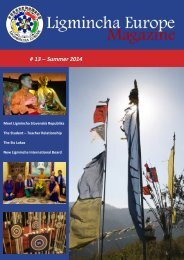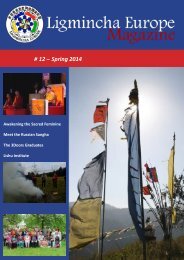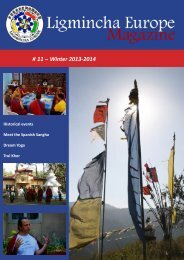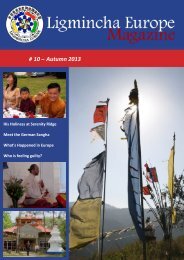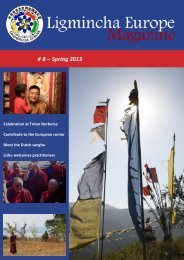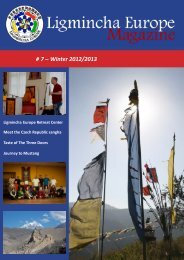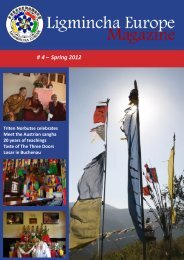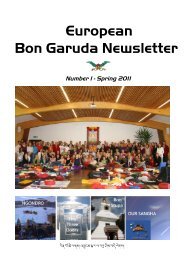Ligmincha Europe Magazine # 9 – Summer 2013
European Magazine of the Ligmincha Sangha of Tenzin Wangyal Rinpoche. Informs about news, events, teachings and projects within the Bon-Buddhist Sangha.
European Magazine of the Ligmincha Sangha of Tenzin Wangyal Rinpoche. Informs about news, events, teachings and projects within the Bon-Buddhist Sangha.
You also want an ePaper? Increase the reach of your titles
YUMPU automatically turns print PDFs into web optimized ePapers that Google loves.
REST IN THE NATURE OF MIND<br />
From March 22 <strong>–</strong> 24, <strong>2013</strong> John Jackson led<br />
the Red Garuda practice in Buchenau, Germany.<br />
On Saturday, after we watched the<br />
live Internet teachings of Tenzin Wangyal<br />
Rinpoche, John talked about how can we<br />
integrate the practice of the Red Garuda<br />
with the practice of the Inner Refuge. Here is<br />
an edited transcript of his explanation.<br />
Traditionally there are three types of Refuge: the<br />
Sutric Refuge, the Tantric Refuge and the Dzogchen<br />
Refuge. We will discuss each of these and<br />
then examine the Inner Refuge that Rinpoche<br />
speaks of, and how it relates to the traditional refuges.<br />
Fundament to all these is the term Refuge.<br />
What exactly does Refuge mean? It means different<br />
things to different people, but generally it is<br />
our source of wisdom. What do we look to for our<br />
source of wisdom? What do we look to in a time<br />
of difficulty and trial? And what do we look to for<br />
the enlightened vision of what might be?<br />
In the Sutric Refuge we take Refuge in the<br />
Buddha, the Dharma and the Sangha. The Buddha<br />
represents the enlightened mind, the Dharma the<br />
great body of teachings, and Sangha the community<br />
of practitioners. This is called the path of the<br />
virtuous adherers, specifically the path of monks<br />
and nuns, those who cultivate virtuous qualities<br />
and try to avoid any negativities in life.<br />
The Tantric Refuge is in Lama, the teacher, Yidam,<br />
the enlightened manifestation, and Khandro, the<br />
supporter of manifestation. The Refuge prayers<br />
that we say as part of many of our practices are<br />
drawn from the Ma Gyud, or Mother Tantra. In<br />
this system the Lama is the representative of the<br />
Buddhamind. It is said that the Lama, our teacher,<br />
is even more precious than the Buddha, because<br />
our Lama is actually the one who gives transmission<br />
into the teachings rather than the historical<br />
Buddha. That is why the Lama in the Tantric<br />
Refuge holds a similar place as the Buddha held in<br />
the Sutric system. The Yidam is in a place similar<br />
to the Dharma, because in the Tantric system the<br />
Yidam gives the direct transmission of wisdom<br />
and energy. So rather than emphasizing the study<br />
of the teachings, through the practice of the<br />
Yidam we receive the essence of the teachings<br />
The Teacher and the Dharma<br />
directly from the source. The Khandros are the<br />
support, for they are the helpers, the active energetic<br />
manifestations of enlightenment. They have<br />
a parallel to the community, the sangha, because<br />
they are like a spiritual community supporting you<br />
in your Tantric practices.<br />
In the Dzogchen teachings the Refuge is said to be<br />
in Tsa, Lung and Tigle. To translate that, Tsa<br />
would be the subtle energetic channels in the<br />
body. Lung is the wind or energy that moves<br />
through these channels. Tigle are the spheres of<br />
wisdom lights that arise during the practices. In<br />
many Tantric and Dzogchen practices Tsa and<br />
Lung are used, because they work with the channels,<br />
the chakras and the wind, and the subtle<br />
energetic results. In Dzogchen the result is many<br />
times through the Tigle, a direct insight or wisdom.<br />
Tenzin Wangyal Rinpoche has evolved a whole<br />
new language in The Three Doors, where he talks<br />
about Stillness, Silence and Spaciousness. I have<br />
known Tenzin Wangyal Rinpoche for twenty-two<br />
years, and over all that time I have observed him<br />
progressively making his teachings simpler and<br />
simpler and simpler, trying to reach the broadest<br />
page<br />
26






